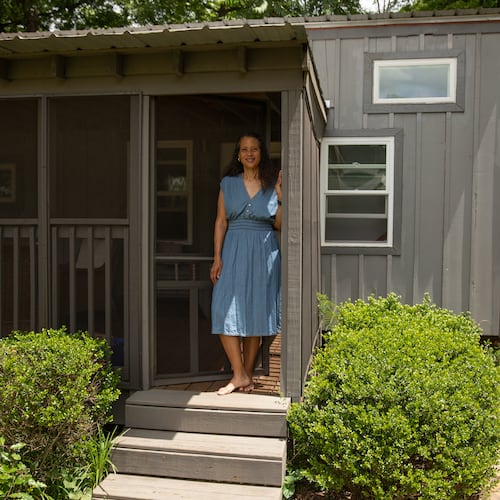WE GO BEYOND THE HEADLINES
Each week, Sunday Business Editor Henry Unger has a candid conversation with a local leader as part of our commitment to bring you insightful coverage of metro Atlanta’s business scene.
Seize the opportunity. If it’s not there, create one.
A.J. Robinson did both in his career, building on one experience after another — many unplanned — to reach his current position as president of Central Atlanta Progress. Robinson, 58, is the point man for boosting downtown Atlanta, which has seen many successes and failures in the decade he has been in charge.
Starting out as young entrepreneur in Knoxville, Robinson ended up in China, helping Atlanta-based Portman Holdings build a signature project in Shanghai. He worked for the Portman real estate development firm for 23 years, becoming its president in 1996 before leaving to head CAP in 2003. He discusses what he learned on his journey, as well as what Atlanta needs to do to compete with other cities.
Q: Was there a person or experience early in your life that helped shape who you are?
A: I'm the product of an entrepreneur who was in the wholesale distribution business for building products in Knoxville. My dad was a great role model that hard work pays off. I worked in the business starting in high school during the summers, doing warehouse work, driving trucks. I learned a lot about what goes into a house, since homebuilders were the classic customer.
After graduating from Emory with an accounting degree, I realized I didn’t want to do that for my entire life. My life changed the one year between Emory and graduate school. I became a homebuilder and customer of my father’s business. I formed a little contracting business to build spec houses. My father fronted the supplies.
I was 22. Lo and behold, I sold both houses. It changed my life. It provided me enough money to pay to go back to school. And the entrepreneurial experience would single me out as a candidate that differentiated me. I got into the Harvard MBA program.
Also, the business helped me develop a heck of a lot of confidence. You have to make a lot of quick decisions and live with them. Building a house from start to finish — you don’t learn that in college.
Q: Did you learn something at Harvard?
A: That experience opened up my whole career. Here I was coming from east Tennessee to a school with people from all over the world — Wall Street, London, China. It opened my eyes.
This was 1979 and 1980. I still couldn’t figure out where I was going to go. The U.S. government was setting up a business school in China, and circulated a list around my class for those interested in being instructors. I got picked. It was literally Harvard Yard graduation one day and Tiananmen Square the next.
We were sent to set up a continuing education program for business people and leaders. We taught basic things about interest rates and the time value of money. When I was there, there was still Marx and Engels and Lenin and Stalin posters all over the place.
I came out of China with a knowledge that a limited number of people had at that time.
Q: How did you parlay that knowledge into a job?
A: The Portman organization was opening an architecture office in Hong Kong. I met Jack Portman (son of John Portman, who founded the Atlanta-based development firm) there. Eventually, that led to a trip to Shanghai, where we started chasing a real estate project.
I spent 23 years with Portman, including about a decade putting together a big project in Shanghai like Peachtree Center in Atlanta. It was 2 million square feet — an office, hotel, theater, housing units — and I was in charge of it.
It took us four years of negotiation and four years to build. The lesson of that is never give up if you’ve got a dream. Be patient and build relationships.
I was able to combine that little experience from building those two houses with my knowledge of China. I parlayed that into a career in international development. The Shanghai project was the carrying card that boosted the Portman organization’s profile in China, India and lots of other places.
Q: You were at Portman Holdings when it was working through serious financial problems? What happened and what did you learn?
A: We got into issues with lenders in the 1990s, which involved four or five years of (financial) workout. Our assets in the U.S. were over-leveraged. It was a tremendous exercise of gaining time and waiting for real estate values to come back, and swapping a lot of that debt into equity positions — much like what's happened (throughout the country) over the past five or six years.
I learned again (about the value) of patience, time, relationships and hard work. Lenders in the 1990s were no different than they were five years ago. If you are forthright, if you have a plan and people have faith that you’re not going to fail — no matter what — then you’ll survive.
The lenders determined that they were in a better position to work out these loans than to push Portman into bankruptcy and collect cents on the dollar. Portman emerged with assets and didn’t look back. Now, they’re doing stuff all over the world.
Again, the lesson is never give up.
Q: Downtown Atlanta has seen many successes and failures during your decade of heading CAP, which is responsible for boosting the central city. Where are we and what do we need to do?
A: I left Portman in 2003. There was a lull downtown from 1996 to 2002 when not much went on. We were in a post-Olympic kind of depression. Then along comes Bernie (Marcus) and the aquarium. Coke gave the land for Bernie's $250 million gift.
The Olympics was one gift and this was another. I started harping that we didn’t want to miss this opportunity. Fast forward to downtown now — there’s the aquarium, World of Coca-Cola, CNN tour. We’ll open the Center for Civil & Human Rights and we’ll open the College Football Hall of Fame. The brand of Atlanta is identified by the central city, and I think we’ve enhanced the brand — slowly.
We’ve got lots of issues. The biggest challenge we face is the perception of public safety — not public safety itself because we can fill everyone up with statistics that the downtown area is one of the safest places in the metro area. But no one believes it.
The perception revolves around our homeless population. That’s something we have not solved, but we are at least changing the model from sheltering and feeding people to housing people first. We’ve been slow to change. We’re not there yet.
If you look around American cities, it’s all about lifestyle and the urban campus — if you want your kids and grandkids to come back after college. It’s not the lifestyle of the 1950s with a house and big yard in the suburbs. Everyone’s getting more urban. I think the Downtown-Midtown-Buckhead corridor has the best infrastructure to provide that kind of lifestyle. We have to. Otherwise, our children and grandchildren are going to go to D.C., New York and San Francisco.
About the Author
Keep Reading
The Latest
Featured


